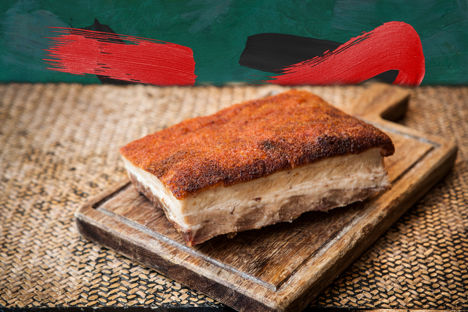
Painting a picture: the Cantonese kitchen
Mukta Das and Andrew Wong explore the three main schools of cooking found in traditional Cantonese cuisine, creating a complex and technical dish that represents each one in a single mouthful.
Painting a picture: the Cantonese kitchen
Mukta Das and Andrew Wong explore the three main schools of cooking found in traditional Cantonese cuisine, creating a complex and technical dish that represents each one in a single mouthful.
A typical Cantonese restaurant is staffed with chefs specialising in three separate fields: wok cookery, dim sum and roasting (or barbecuing). Food anthropologist Mukta Das and Michelin-starred chef Andrew Wong explain just how complicated and in-depth specific culinary skills can be in China, both historically and today, before sharing a recipe that brings all three Cantonese skillsets together in one dish. Read on to learn more about this topic, or click the image below to discover more articles and recipes that shed light on China's rich culinary history.
Yǎngshēng [養生] in Zhuāngzi [莊子] in Sterckx, R., 2011. Cooking the World in Food, Sacrifice and Sagehood in Early China translated by Roel Sterckx. New York: Cambridge University Press
Andrew Wong: On the menu at A Wong there’s a dish I call ‘The Cantonese Kitchen’ because this is one of the only dishes that I have cooked that uses all three traditional Cantonese cooking techniques. It requires different kinds of knife work to do justice to a piece of pork and starts off with traditionally roasting a piece of pork belly, which involves a process which takes well over twenty-four hours to get the pork skin as it should be. Then we chill it, take the skin off, and then into the dim sum kitchen it goes, where we make a prawn paste to spread onto the crisp skin. After it is set, it gets sent to the wok kitchen and it’s fried at a low temperature in order to re-crisp the skin and cook the base through.
Mukta Das: Handling, cutting and cooking meat was a skilled job – meat was reserved for special rituals and given as gifts after feasts. The Rites of Zhou describes how complicated and varied the Chinese kitchen was. In this Confucian text, there are 2,271 dieticians, food handlers and cooks to organise in the Imperial court. Each animal had its own major officer and his staff. There were six officers for chicken, thirteen for sheep and fish had a high status. But mostly meat and fish were cooked using spits, tripods and cauldrons. It wasn’t until the Han Dynasty that steaming became popular, along with using oils extracted and milled from vegetable seeds. This heralded the start of the classic roasting, steaming and frying separation of the Chinese professional kitchen.
AW: There are a lot of similarities between this historical picture of the Chinese kitchen and what we do today. Nearly all dim sum cookery is labour-intensive, with a lot of work and specialism going into something so small. The same goes for Chinese barbecue – if you want to be good at it then you have to be doing it all the time, and many chefs remain on that station for their entire careers, experimenting, failing and succeeding before passing on their knowledge to apprentices.
MD: Tomb carvings and murals carved out during the Han Dynasty and excavated in the 1960s and 1970s depict kitchen and dining scenes. Many scenes are concerned with butchery and the proper handling of meat. Chef Ding, the breakout character (for us food history nerds anyway) in Daoism’s central text, the Dao De Jing by Laozi, is a master butcher. His skill with butchering – finding the openings, going with the natural contours of the animal – is used as an analogy for living life.
AW: Pork belly is a really popular cut in Chinese cooking, even though Peking duck has been the centrepiece of the roasting kitchen from at least the Ming Dynasty. Freshly chopped prawn paste is a classic dim sum ingredient, and the Cantonese prawn pastes demand the kind of fine knife work displayed by Chef Ding. But putting fresh prawn paste together with pork belly is unusual and, aftter examining the kitchen murals with Mukta, I doubt this would have been done during Han times either. The plum sauce is a traditional condiment for roast meat, providing that all-important acidity to counteract the fatty oiliness. The truffle is a chef’s decision more than anything, as it adds a further aroma to the plate.
MD: The Cantonese kitchen has always been a frenetic place housing many specialists who are tasked with doing one thing very well, such as barbecuing meat, making pastry or preparing sauces and condiments. A single dish could have the input of tens of specialist cooks before being brought out to the vast dining rooms of the Cantonese teahouses and consumed with relish.

